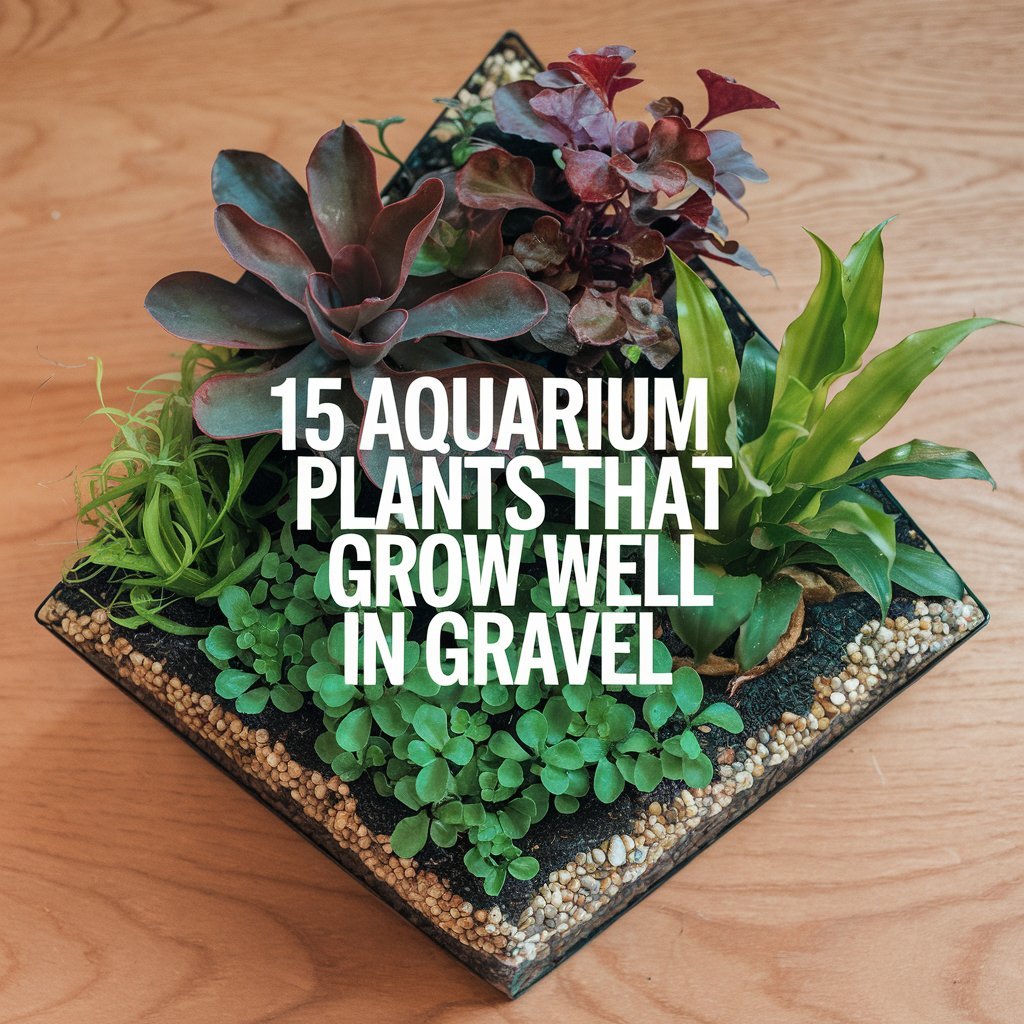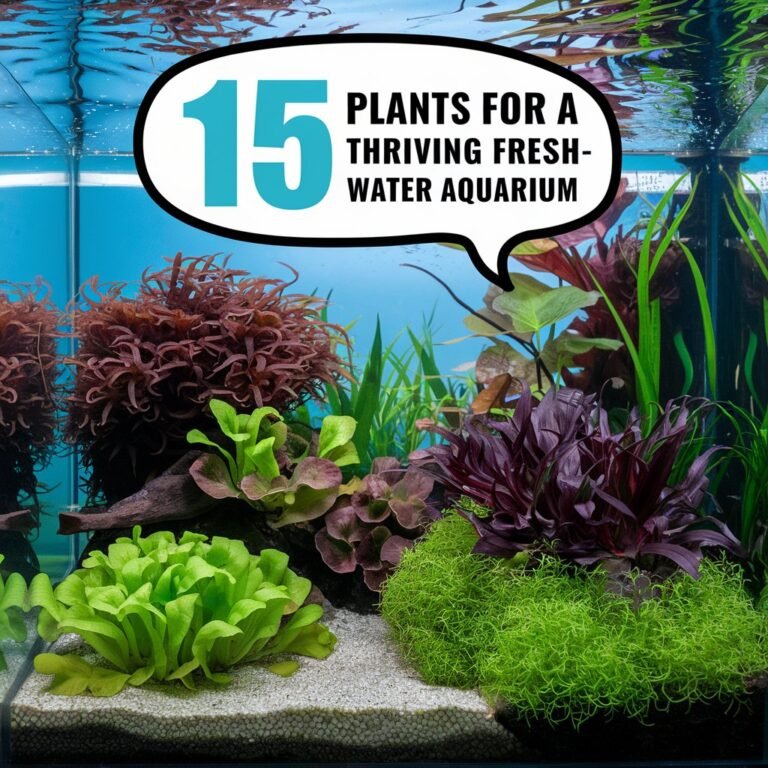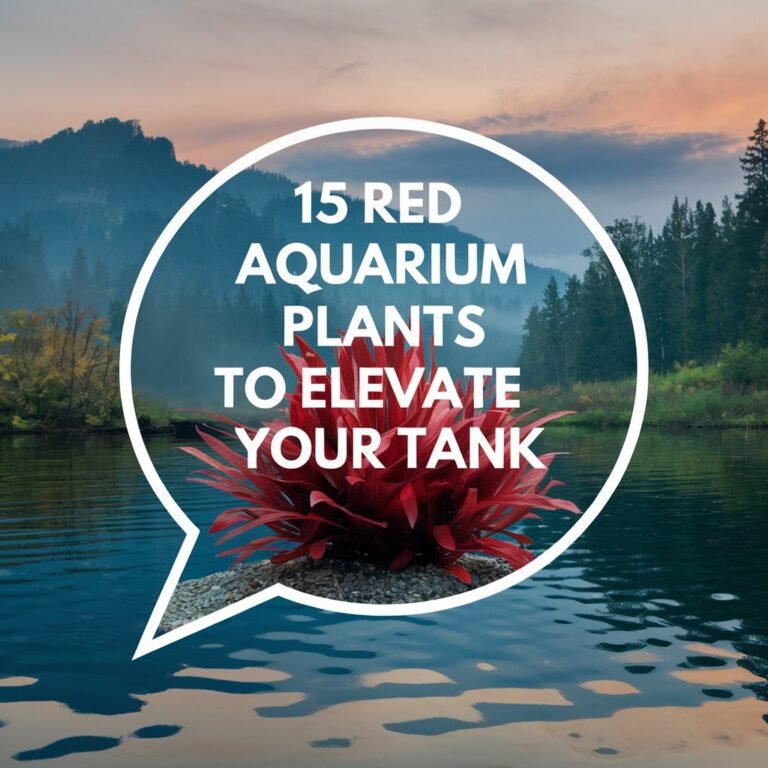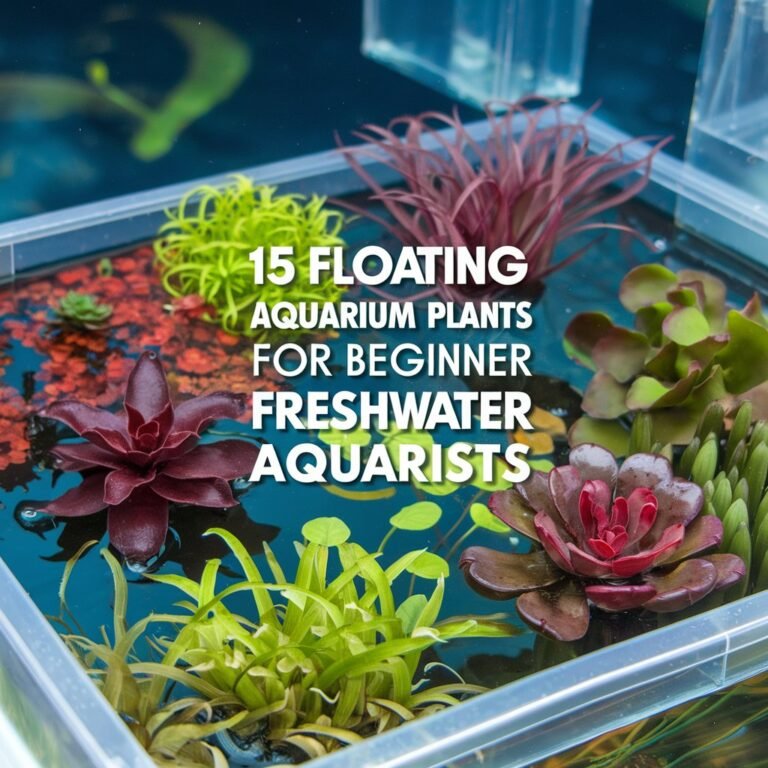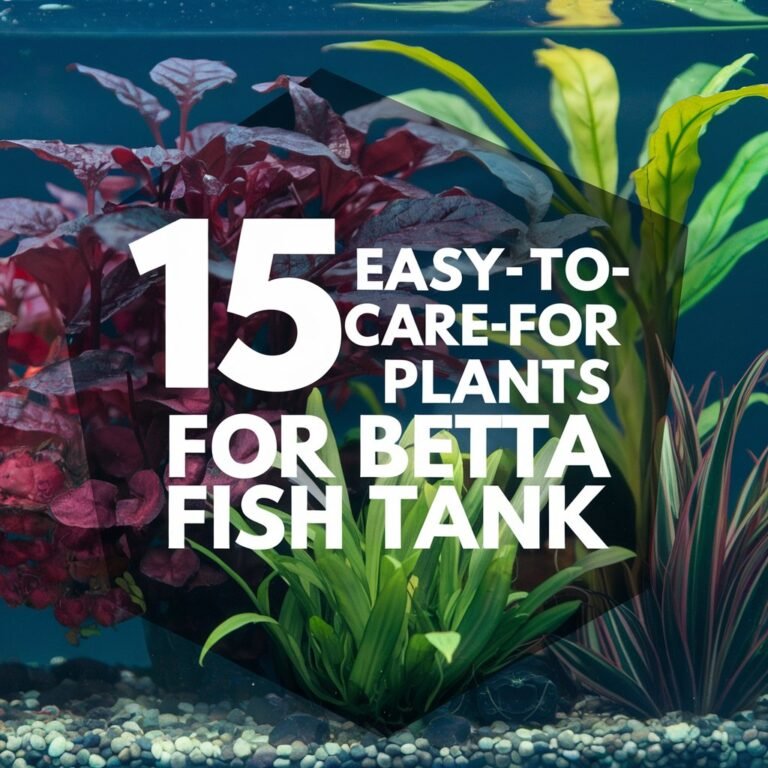15 Aquarium Plants That Grow Well in Gravel
You’re looking to create a stunning aquarium setup with gravel as the base. Choosing the right plants can make all the difference. This year, consider the top 15 aquarium plants that thrive in gravel. From low-maintenance options like Ludwigia and Pogostemon to more demanding plants like Cryptocorynes and Water Sprite, there’s something for every aquarist.
But what sets these plants apart, and how can you guarantee they flourish in your gravel-based aquarium? To find out, let’s take a closer look at the unique needs and benefits of each plant, starting with some of the most popular options.
In A Nutshell
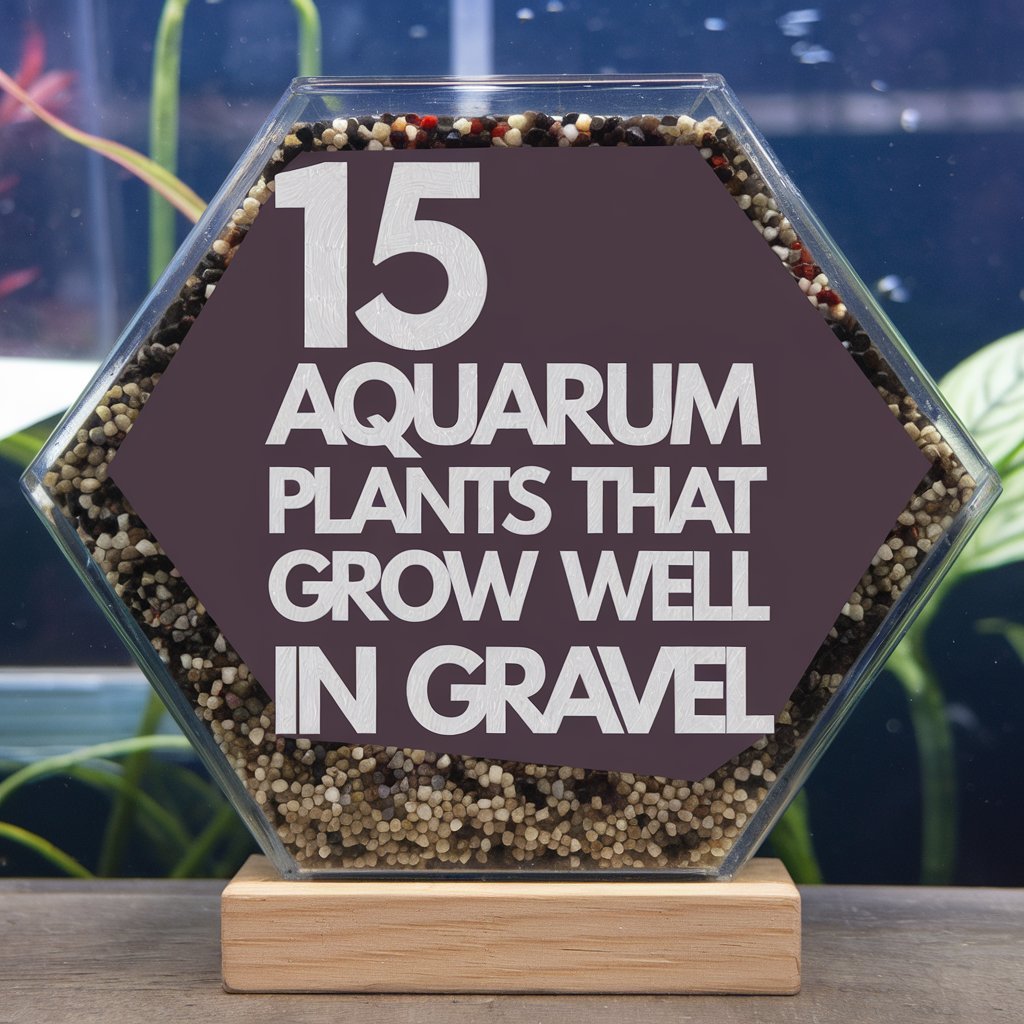
- Ludwigia and Echinodorus plants thrive in gravel substrates with at least 2-3 inches of coverage.
- Gravel substrate provides essential nutrients and promotes a robust root system for plants like Ludwigia and Echinodorus.
- Plants like Java Moss and Anubias require moderate to high lighting and specific water parameters to grow well in gravel.
- Regular fertilization and pruning are crucial for maintaining healthy plant growth in gravel substrates.
- Plants like Pogostemon and Rotala can tolerate a range of water conditions and are suitable for gravel aquariums.
Java Moss for Gravel Aquariums
Growing Java Moss in gravel aquariums can be a rewarding experience, especially when done correctly.
You’ll need to start by selecting a healthy Java Moss specimen with dense, vibrant green growth. To attach the moss to rocks or decorations, use a fishing line or a plant-safe adhesive. This will prevent the moss from floating away and guarantee it starts to grow on the desired surface.
When it comes to Moss aquascaping, you can use Java Moss to create a variety of unique designs.
You can attach it to rocks, driftwood, or even create a moss wall. To achieve this, you’ll need to tie or glue the moss to a mesh or a grid, and then attach it to the aquarium.
For successful Moss propagation, you’ll need to provide Java Moss with the right conditions.
This includes moderate to high lighting, temperatures between 72-82°F (22-28°C), and a pH range of 5.5-8. You should also fertilize the moss regularly to promote healthy growth.
With proper care, Java Moss can thrive in a gravel aquarium and become a beautiful addition to your underwater landscape. Regular pruning and maintenance are essential to keep the moss healthy and looking its best.
Amazon Swords Plant Care
Amazon Swords plants, known for their striking leaves and versatility in aquarium design, require attentive care to thrive in gravel aquariums.
You’ll need to provide them with moderate to bright lighting, with a minimum of 2-3 watts per gallon. Maintain a water temperature between 72-82°F (22-28°C) and pH levels between 6.5-7.5.
To guarantee ideal growth, you’ll need to fertilize your Amazon Swords plants regularly. Swords Plant Fertilization involves providing essential nutrients such as nitrogen, phosphorus, and potassium.
You can use a balanced fertilizer, but make sure to follow the manufacturer’s instructions to avoid over-fertilization.
Amazon Swords Propagation is relatively easy and can be done by dividing the rhizome or by separating the plantlets that grow around the base of the plant.
When propagating, make sure to provide the new plants with a nutrient-rich substrate and plenty of light.
Regular pruning is also necessary to maintain the plant’s shape and promote healthy growth.
By following these care guidelines, you’ll be able to enjoy the beauty and benefits of Amazon Swords plants in your gravel aquarium.
Regular monitoring of water parameters and plant health will also help prevent any potential issues.
Gravel Loving Anacharis Plants
When you’re looking for an aquarium plant that thrives in gravel without demanding a lot of maintenance, Anacharis plants are an excellent option.
These plants can tolerate a wide range of water conditions and can grow well in both low- and high-light environments. One of the key benefits of Anacharis plants is their ability to absorb excess nutrients from the water, which helps to prevent algae growth.
Anacharis plants can grow well in gravel, but they can also thrive in sand.
However, gravel is generally a better option for these plants, as it provides better aeration and water circulation. Gravel also allows the roots of the Anacharis plant to grow deeper, which helps to anchor the plant in place.
In contrast, sand can compact over time, which can limit the growth of the plant’s roots.
Growing Cryptocorynes in Gravel
Thriving in both low- and high-light conditions, Cryptocorynes can be an ideal choice for aquariums with varying lighting setups.
This adaptability allows you to create visually stunning and unique aquatic landscapes with various Cryptocoryne species. However, providing proper Cryptocoryne care is vital to promote healthy growth in gravel.
You should choose a suitable gravel substrate that’s gentle on the roots, ideally between 2-4 mm in size, allowing for efficient root development and water circulation.
For peak growth, Cryptocoryne plants require balanced fertilization and adequate CO2 supply.
It’s also essential to maintain water parameters suitable for these plants, with a pH between 6.0 and 7.5, water hardness around 1-8 dGH, and water temperatures ranging from 68-82°F (20-28°C).
With proper care and conditions, Cryptocorynes can thrive in gravel.
Divide the roots periodically to prevent them from becoming too dense and promote further growth.
Regular pruning also helps maintain the plant’s shape and encourages new growth, resulting in an attractive and lush aquatic environment.
Gravel Suitable Water Wisteria
By choosing Water Wisteria for your aquarium, you’re selecting a versatile and attractive plant that thrives in a variety of gravel substrates.
This plant can be grown in coarse or fine gravel, making it a great option for aquarists who want flexibility with their substrate.
When it comes to Water Wisteria care, crucially, you must choose a gravel substrate that allows for good water circulation and nutrient uptake.
A substrate with a medium to fine grain size is ideal, as it provides a stable base for the plant’s roots to anchor.
In terms of specific gravel characteristics, Water Wisteria does well in substrates with a pH between 6.5-7.5 and a moderate level of hardness.
Avoid using gravel with high levels of calcium carbonate, as this can lead to pH fluctuations.
A depth of 1-2 inches is sufficient for Water Wisteria, as its roots don’t require a lot of space to grow.
By providing the right gravel substrate and proper care, you can enjoy the beautiful, flowing stems of Water Wisteria in your aquarium.
Regular pruning and fertilization will also help to promote healthy growth and prevent the plant from becoming leggy.
Easy to Grow Vallisneria
You can easily establish Vallisneria in a variety of gravel substrates, making it an excellent choice for aquarists who want low-maintenance, attractive plants.
To grow Vallisneria successfully, follow these Vallisneria care tips: maintain water temperatures between 65°F to 85°F (18°C to 30°C) and pH levels between 6.0 and 8.0. Vallisneria thrives in well-lit conditions but can tolerate moderate to low light.
There are several Vallisneria species types to choose from, including Vallisneria americana, Vallisneria nana, and Vallisneria tortifolia.
The most common species is Vallisneria americana, which grows up to 6 feet (1.8 meters) in length and can be trimmed to maintain a desired height.
Vallisneria nana and Vallisneria tortifolia are more compact varieties that grow up to 2 feet (0.6 meters) in length.
Regular pruning is essential to promote healthy growth and prevent overgrowth.
Gravel Based Anubias Plants
Certain species of Anubias plants are well-suited for growth in gravel substrates, and with their low-maintenance requirements, they’ve become popular among aquarists.
If you’re considering growing Anubias plants in gravel, crucially, you must understand their growth habits and requirements.
Anubias plants typically produce long, sturdy rhizomes that can anchor themselves to gravel substrates with ease.
To promote root development, you’ll need to provide your Anubias plants with a nutrient-rich environment and stable water parameters.
When planting Anubias in gravel, use gravel anchors to secure the rhizome in place.
This will prevent the plant from floating to the surface or getting washed away by water currents.
As the plant grows, its roots will develop and spread throughout the gravel substrate.
To encourage healthy root growth, avoid compacting the gravel or disturbing the plant’s roots.
Best Gravel for Cabomba Plants
Choosing the right gravel for your Cabomba plants can make all the difference in their growth and overall well-being.
Cabomba plants thrive in fine to medium-grained gravel types that allow for easy root penetration and nutrient uptake. Avoid using coarse or large-grained gravel, as it can cause root damage and impede plant growth.
When selecting gravel for your Cabomba plants, consider the following factors: particle size, porosity, and pH compatibility.
Fine-grained gravel with a particle size of 1-3 mm is ideal for Cabomba plants. Porous gravel types, such as those made from volcanic rock or ceramic materials, can provide better water circulation and nutrient exchange. Additionally, guarantee that the gravel type you choose is compatible with the pH requirements of your Cabomba plants, which prefer slightly acidic to neutral water conditions (pH 6.5-7.5).
Some suitable gravel options for Cabomba plants include Seachem Fluorite, Eco-Complete, and CaribSea Super Naturals.
These gravel types offer a balance of fine particle size, porosity, and pH compatibility that supports healthy Cabomba growth. By choosing the right gravel for your Cabomba plants, you can create a thriving aquarium environment.
Gravel Loving Hornwort Plants
As we consider various plants suitable for growing in gravel, it’s clear that the requirements of these species often vary greatly.
One plant that adapts exceptionally well to gravel environments is Hornwort. Hornwort is a floating plant that can thrive in a variety of water conditions and can easily anchor itself in gravel substrates.
To promote healthy growth, guarantee that your aquarium’s water parameters are within the ideal range for Hornwort. This includes maintaining a pH between 6.0 and 7.5, and water temperatures between 72°F and 82°F.
Hornwort propagation is relatively easy, as it can be done by simply cutting the plant into smaller sections and reattaching them to the gravel.
Hornwort maintenance involves regular pruning to prevent overgrowth and promote healthy development.
When planting Hornwort in gravel, it’s crucial to choose a substrate with a suitable grain size to prevent the plant’s roots from becoming lodged.
A medium to coarse-grained gravel is ideal for Hornwort, as it allows for proper root growth and prevents the plant from becoming dislodged.
With proper care and maintenance, Hornwort can thrive in a gravel environment, providing a beautiful and unique addition to your aquarium.
Planting Gravel With Echinodorus
You’re now moving on to another versatile plant that thrives in gravel environments: Echinodorus.
This plant is relatively easy to care for and can adapt to various lighting conditions, making it a great choice for many aquariums.
When planting Echinodorus in gravel, you’ll need to verify the substrate is deep enough to accommodate its root system.
A minimum of 2-3 inches of gravel coverage is recommended to allow the roots to spread out.
Plant spacing is also vital when working with Echinodorus.
You should leave about 1-2 inches between each plant to prevent overcrowding and allow for proper growth.
Overcrowding can lead to reduced growth rates and increased competition for nutrients.
By providing adequate space, you’ll be able to enjoy the full potential of your Echinodorus plants.
When planting, gently separate the roots and place the plant in the gravel.
Make sure the crown is above the substrate, and the roots are buried.
You can use a planting tool or your fingers to secure the plant in place.
With proper care and maintenance, your Echinodorus plants will thrive in their gravel environment.
Gravel Suitable Water Clover
When it comes to growing Water Clover (Marsilea mutica) in an aquarium, choosing the right gravel is crucial. Water Clover is a carpeting plant that thrives in well-oxygenated, nutrient-rich environments. To create an ideal habitat for this plant, look for gravel that is specifically designed for aquatic plants.
A good option is a nutrient-rich, fine-grained gravel with a diameter of around 1-2 mm. This type of gravel allows for good water circulation, prevents the plant’s roots from getting tangled, and provides a stable anchor for the plant to grow.
Additionally, consider using a gravel that is rich in iron, as Water Clover is a heavy feeder and will benefit from the extra nutrients. Avoid using coarse or rough gravel, as it can damage the plant’s delicate roots and hinder its growth.
Gravel Based Ludwigia Plants
Ludwigia plants thrive in a well-maintained gravel substrate, where they can absorb essential nutrients and develop a robust root system.
As you set up your aquarium, guarantee you provide a gravel coverage of at least 2-3 inches to allow for adequate root growth. This depth will also prevent the plants’ roots from getting tangled in the filter or other equipment.
There are several Ludwigia varieties that excel in gravel-based aquariums, including Ludwigia palustris, Ludwigia arcuata, and Ludwigia brevipes.
These plants can grow quite tall, reaching up to 12 inches in height, and can be trimmed to maintain a desired shape or size. Ludwigia plants require moderate to high lighting and should be fertilized regularly to promote healthy growth.
Water circulation is also vital, as stagnant water can lead to root rot and other issues.
By providing the right conditions, you can enjoy the vibrant colors and textures of Ludwigia plants in your gravel-based aquarium. With proper care, these plants can thrive and become a stunning addition to your aquatic landscape.
Regular maintenance will also prevent the buildup of debris and promote a healthy ecosystem.
Gravel Loving Pogostemon Plants
When setting up a thriving aquarium, selecting plants that complement your gravel substrate is key to creating a balanced ecosystem.
Pogostemon varieties are ideal for gravel-based aquariums due to their adaptability and aesthetic appeal. These plants are known for their unique foliage and vibrant colors, adding visual interest to your aquarium.
You can choose from various Pogostemon varieties, such as Pogostemon stellatus, Pogostemon helferi, and Pogostemon erectus, each with its distinct characteristics.
Pogostemon stellatus, for example, features star-shaped leaves, while Pogostemon helferi has distinctive, curved leaves.
Pogostemon propagation is relatively straightforward.
You can propagate these plants by cutting the stems just above a node, allowing the cut ends to heal for a few days before planting them in your gravel substrate.
Make sure to provide your Pogostemon plants with adequate lighting, nutrients, and water circulation to promote healthy growth.
Regular pruning and maintenance will also help maintain their shape and encourage new growth.
Gravel Suitable Rotala Plants
Several Rotala species thrive in gravel-based aquariums, making them a popular choice among aquarists.
You can choose from various Rotala varieties, such as Rotala rotundifolia, Rotala wallichii, and Rotala macrandra, which are well-suited for gravel substrates.
These plants are relatively easy to care for and can tolerate a range of water conditions.
When planted in gravel, Rotala plants benefit from the substrate’s ability to provide a stable and well-oxygenated environment.
Gravel substrate benefits include improved water circulation, which helps to prevent the buildup of debris and promotes healthy root growth.
Additionally, gravel allows for better nutrient uptake, as the plant’s roots can easily absorb nutrients from the surrounding water.
To guarantee the success of your Rotala plants in gravel, make sure to provide them with adequate lighting and nutrients.
Regular pruning is also necessary to maintain their shape and promote healthy growth.
With proper care, Rotala plants can thrive in gravel-based aquariums, adding a touch of elegance and beauty to your underwater landscape.
Gravel Based Water Sprite
Planting Water Sprite in a gravel-based aquarium can be a great way to add variety and texture to your underwater landscape.
This versatile plant can thrive in a well-maintained gravel substrate with proper care. When choosing gravel for your Water Sprite, look for a medium to fine gravel texture, as this allows for ideal root growth and water circulation.
Avoid using coarse or very fine gravel, as it may cause root damage or hinder plant growth.
To guarantee healthy growth, provide your Water Sprite with moderate to high water circulation. This can be achieved by placing the plant near a powerhead or adjusting the direction of your aquarium’s filter outlets.
Water Sprite can grow in a variety of lighting conditions, from low to high, but it prefers moderate to high lighting for ideal growth.
When planting Water Sprite in gravel, gently separate the roots and plant the rhizome about 1-2 inches deep.
Secure the plant with a small rock or plant weight if necessary. Monitor water parameters and maintain ideal water conditions to promote healthy growth and prevent disease.
Frequently Asked Questions
Can I Grow Aquarium Plants in Colored Gravel?
You can grow plants in colored gravel, but guarantee the dye is non-toxic and won’t leach chemicals. Consider gravel aesthetics and compatibility, as some plants may struggle with certain dyes or gravel sizes affecting root growth.
How Often Should I Replace Gravel in Aquarium?
You’ll need to assess gravel maintenance regularly, as its lifespan typically spans 2-5 years. Over time, debris accumulates, and gravel breaks down, affecting water quality, so plan to replace it every 2-3 years for ideal aquarium health.
Will Gravel Cause Algae Growth in the Aquarium?
You’ll minimize algae growth by maintaining proper water circulation, monitoring nutrient levels, and performing regular water changes. Regularly vacuuming and rinsing your gravel also helps, as it removes debris and excess nutrients that fuel algae growth.
Can I Use Gravel From My Garden for Aquarium Plants?
You shouldn’t use gravel from your garden for aquarium plants due to potential garden soil risks, as it can introduce unwanted organisms and cause a nutrient imbalance, disrupting the aquarium’s delicate ecosystem balance.
FInal Verdict
You’ve now explored the top 15 aquarium plants that thrive in gravel-based setups. From low-maintenance options like Ludwigia and Pogostemon to more demanding species like Cryptocorynes and Echinodorus, each plant offers unique benefits and requirements.
By choosing the right plants and understanding their specific needs, you’ll create a balanced and visually stunning aquarium that flourishes in its gravel environment, providing a healthy habitat for your aquatic life. Regular maintenance is key to long-term success.
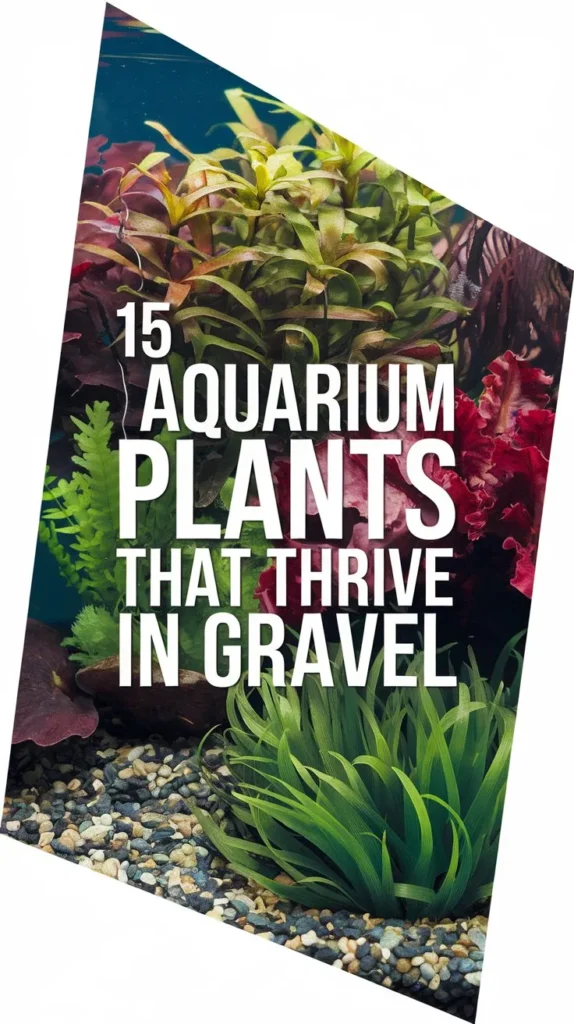
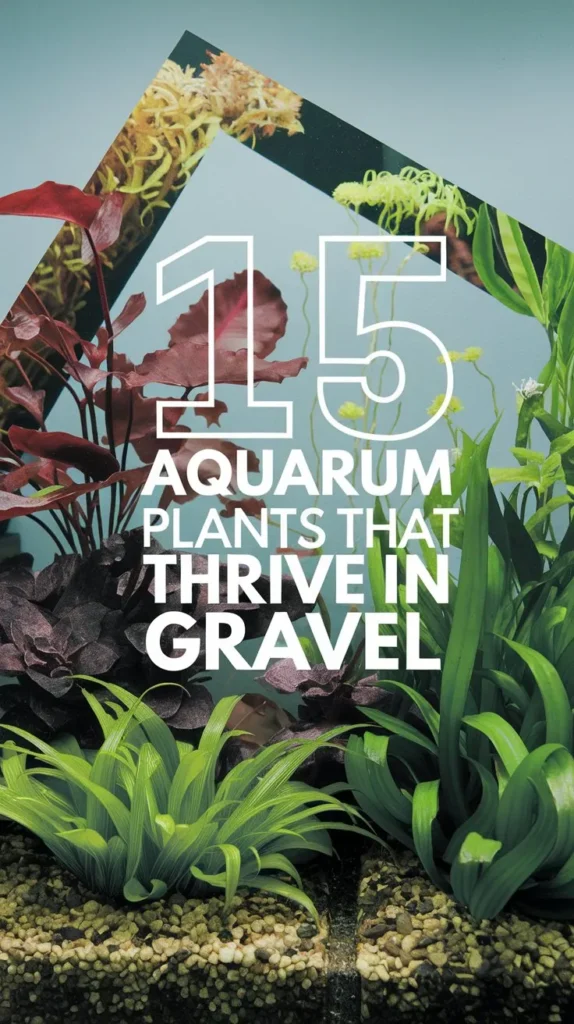
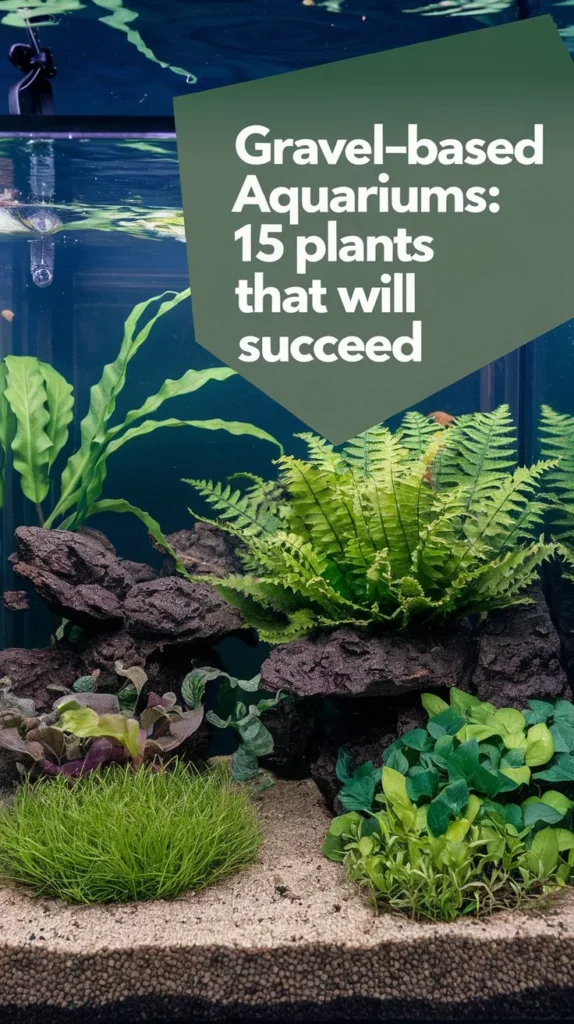
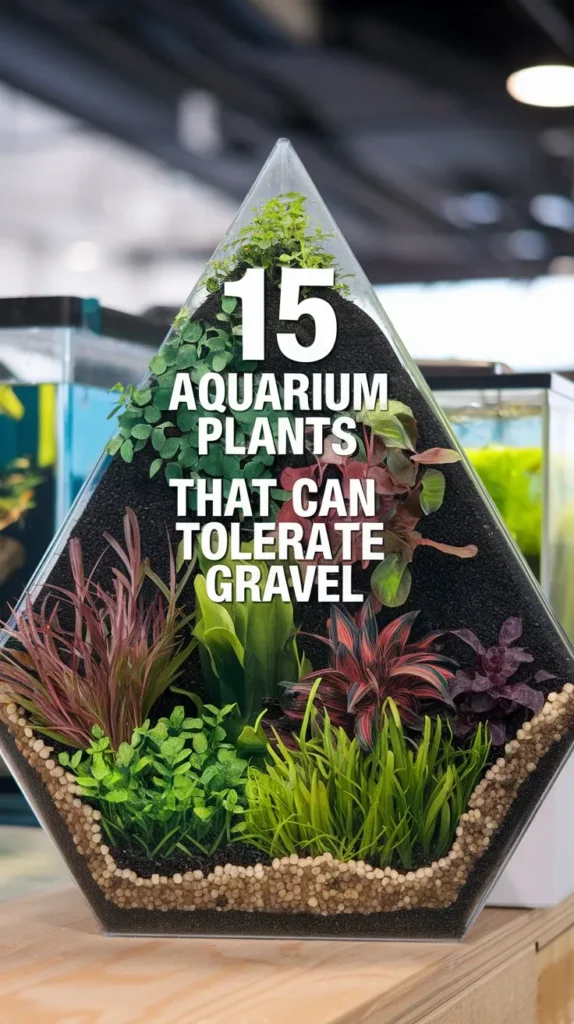
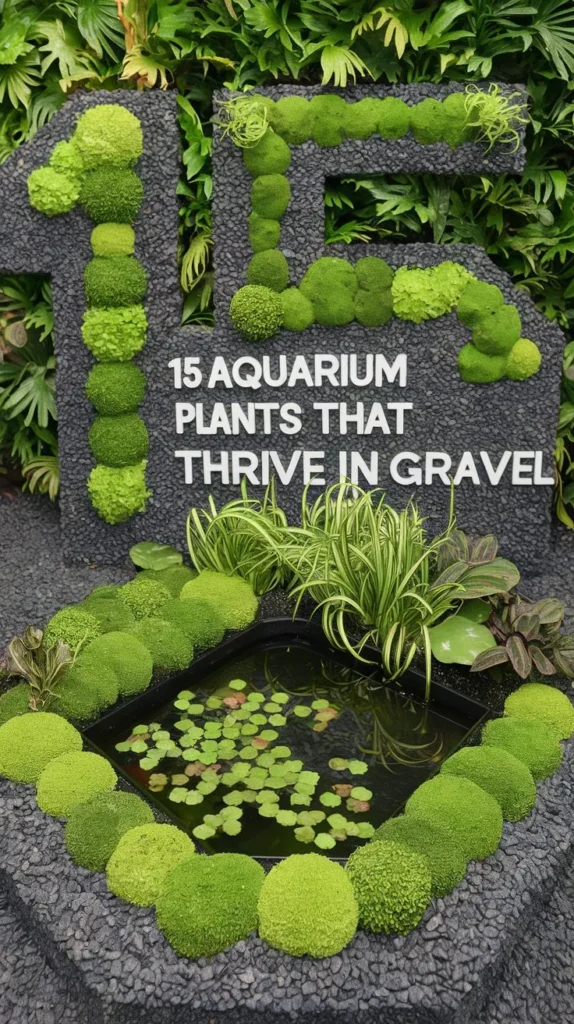
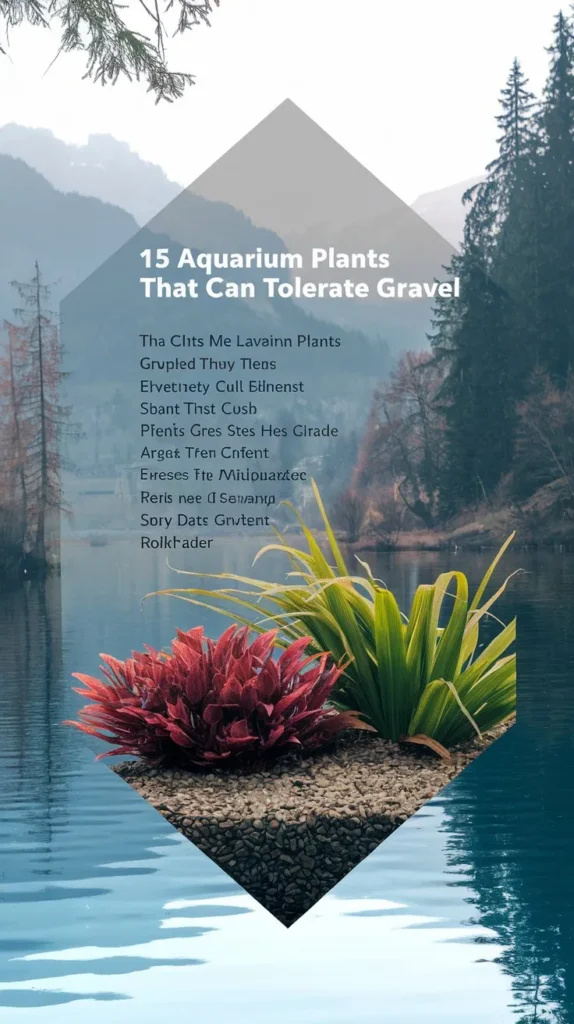
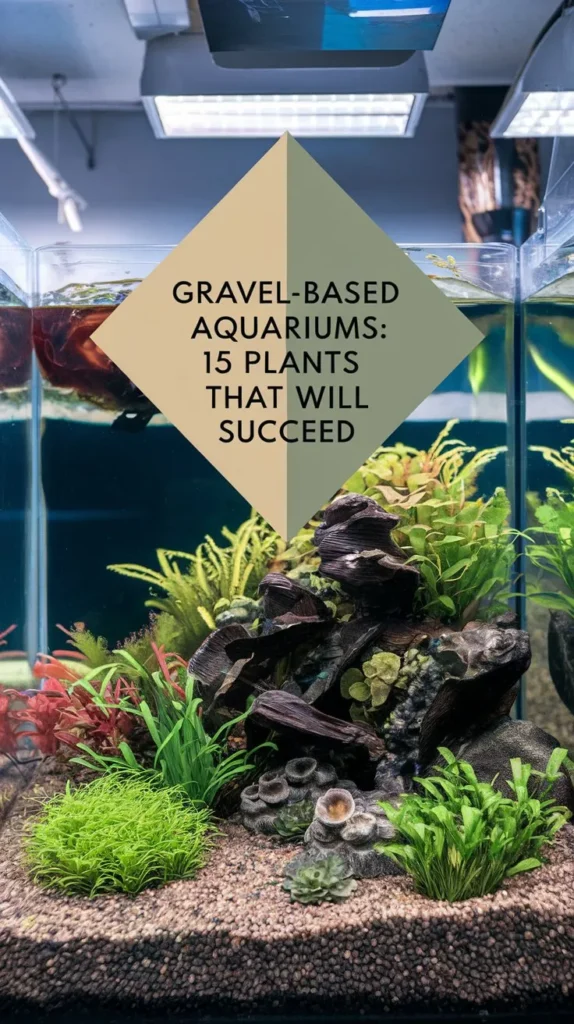
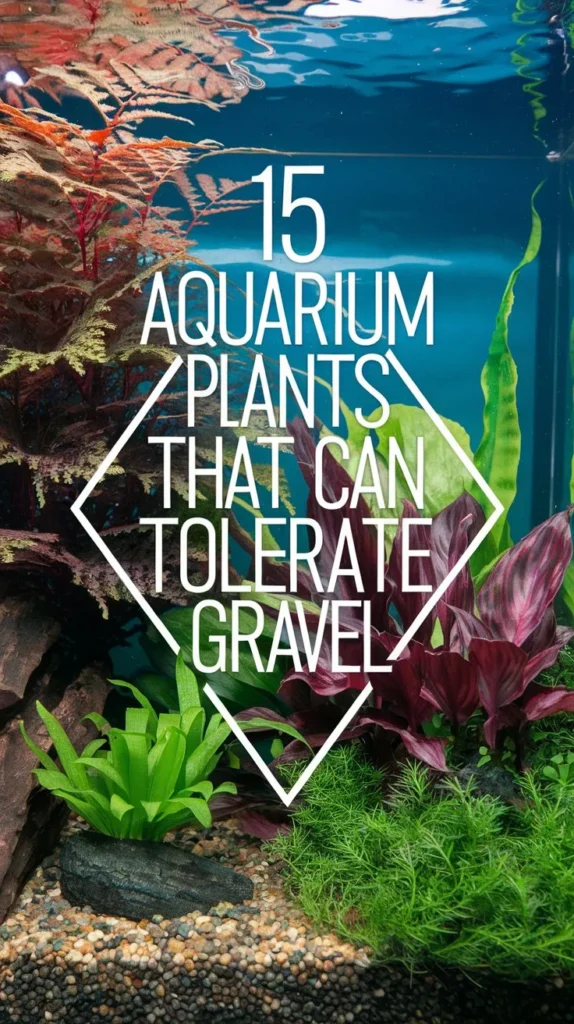

Hello, I’m Aria Cooper, the heart and soul behind Swimmy Buddies. As a devoted fish aficionado, I share my aquatic adventures and expertise to inspire your own underwater explorations. 🐠🌊

